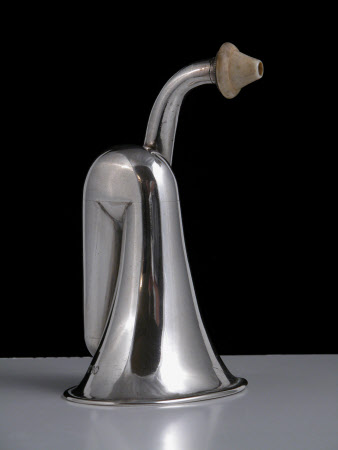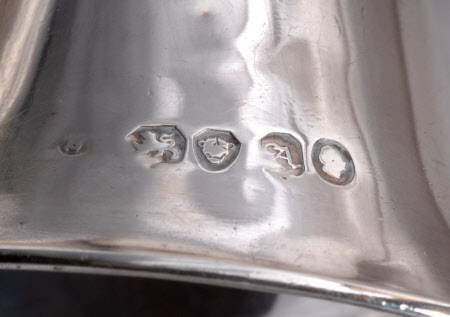Ear trumpet
probably Charles Reily and George Storer
Category
Silver
Date
1836 - 1837
Materials
Sterling silver and ivory
Measurements
125 mm (H)
Place of origin
London
Order this imageCollection
Greenway, Devon
NT 121393
Summary
Ear trumpet, probably Charles Reily and George Storer (fl. 1829-c.1855), sterling silver, London, 1836/7. The ear trumpet is of bugle form with a flaring conical aperture, or bell, and a tapering, folded stem terminating in a shaped ivory earpiece.
Full description
Ear trumpets as hearing aids have been in existence since at least the 17th century and probably since antiquity, when use would have been made of hollowed out animal horns.[1] Francis Bacon, 1st Viscount St Alban (1561-1626) wrote as follows in Sylva Sylvorum or a Natural History In ten Centuries, first published in 1627: ‘Let it be tryed, for the help of the Hearing (and I conceive it likely to succeed) to make an Instrument like a Tunnel; the narrow part whereof may be of the bigness of the hole of the Ear; and the broader end much larger like a Bell at the skirts, and the length half a foot or more. And let the narrow end of it be set close to the Ear. And mark whether any Sound abroad in the open Air, will not be heard distinctly from further distance, than without that instrument; being (as it were) an Ear Spectacle.’[2] Bacon suggested that such a device was then in use in Spain and it is clear that by the late 17th century they were elsewhere in Europe too, almost certainly including England. The Dutch physician, Frederick Dekkers depicted several varieties of ear trumpet in his 1694 publication, Exercitationes Practicæ circa Medendi Methodum, including one of coiled form akin to the French horn which would have to have been made of metal.[3] There are numerous illustrations from the second half of the 18th century showing ear trumpets in use, particularly in cartoons and caricatures such as the etching entitled ‘Friends by the Ears’ of 1786 in which a stockbroker feigns deafness to avoid paying the man who claims to have restored his hearing.[4] Perhaps the most famous adopter of the ear trumpet in this period was Sir Joshua Reynolds who is depicted holding one, which appears to be silver, in Johann Zoffany’s painting of 1771-2, The Academicians of the Royal Academy (Royal Collection Trust, ref. RCIN 400747). By the 1820s the bugle form, like the example at Greenway, was an option and the few other surviving examples in silver of this type all have the maker’s mark of Charles Reily and George Storer who registered their partnership with the Goldsmiths’ Company in 1829.[5] They were well-suited to the intricate and scientific work required, Reily having previously produced fine quality small wares including snuff boxes whilst in partnership with his mother and Storer having been apprenticed as a watchmaker.[6] In having a fixed rather than detachable bell the Greenway trumpet differs from those clearly bearing Reily and Storer’s mark but it is otherwise very similar in form making them the most likely manufacturers in this case also. Agatha Christie and Sir Max Mallowan were avid collectors of silver, their aim as recorded by Sir Max being to collect pieces for each year of manufacture up to the accession of Queen Victoria in 1837.[7] This is clearly corroborated by Agatha Christie's plate list, which is in her own hand and comprises both a catalogue of the silver and a chronological list, the earliest piece being dated 1648/9 and the latest 1836/7.[8] Focus seems to have been on the 18th century and only three years (1729, 1743 and 1757) remained unrepresented in the collection. The large proportion of silver from the last quarter of the century may indicate that that period was especially favoured or merely reflect that plate of that era survived in greater quantity and was thus more readily available. In total Agatha Christie listed 290 pieces in her plate list, these comprising 90 or so different objects which represented the myriad different domestic uses of silver in the 18th century - from candlesticks, cutlery and tea pots to bleeding bowls and ear trumpets. Certain objects must have been of particular interest and there were large numbers of fish slices (24), casters (16), tea pots (9), cream jugs (6) and sugar baskets (4). There were also curiosities, such as a brandy dipper, two ear trumpets (only that of 1836/7 remains at Greenway) and a "mousetrap supper dish" (no longer part of the collection). Purchases were made from dealers and auction houses across the country and even as far afield as India, the details being recorded in the plate list along with notes on makers, dates, assay offices and armorials. The document, with the twenty or so surviving pieces at Greenway, constitutes an interesting and important snapshot of silver collecting in the mid-20th century by methodical and serious collectors who reflected the preference of the times for the pre-Victorian era. Agatha Christie and Sir Max pursued an almost scientific approach which was particularly well-suited to silver, with its hallmarks providing clear-cut dating as well as details of the place of manufacture and the maker. The ear trumpet has great potency in this context too, as it represents the final year of their collecting range. It is recorded in the plate list as W. 222, the ‘W’ standing for Winterbrook, Agatha Christie’s and Sir Max’s house on the edge of Wallingford in Oxfordshire where most of the silver was kept up to their deaths. In this instance they purchased from Charles Shapland, a long-established silver dealer whose premises were at 207 High Holborn, London until the 1980s.[9] James Rothwell, National Curator, Decorative Arts August 2023 NOTES: [1] A timeline is given on the website of the Packington Collection of ear trumpets, the world’s largest and most comprehensive which is now on display in Oswestry Museum: https://www.eartrumpets.net/timeline.php. [2] Francis Bacon, Viscount St Alban, Sylva Sylvorum: or a Natural History, In ten Centuries, London, 1670, p. 62. [3] Frederick Dekkers, Exercitationes Practicæ circa Medendi Methodum, Leiden, 1694, tab. II, figs 1-3. This illustration and many other sources are on the website of the Packington Collection of ear trumpets (see note 1). [4] Wellcome Collection, ref. 10958i. [5] One of 1830/1 was with Alastair Dickenson Ltd in 2023 and another, of 1835/6, is in the Packington Collection at Oswestry Museum. [6] Arthur Grimwade, London Goldsmiths 1697-1837, 1990, pp. 639 & 671-2. [7] Information from Sara Burdett. [8] Copy of Agatha Christie's plate list, National Trust, Greenway House. [9] Information on Charles Shapland, whose shop was named ‘Shapland’, from the University of Leeds antique dealers’ archive: https://antiquetrade.leeds.ac.uk/dealerships/34883
Provenance
Acquired by Agatha Christie and Sir Max Mallowan from Shapland, 207 High Holborn, London. By descent to Matthew Pritchard by whom given to the National Trust in 2006.
Credit line
Greenway, the Agatha Christie Collection (National Trust)
Marks and inscriptions
Outside of trumpet bell : Hallmarks: a poorly struck, rubbed and indecipherable maker’s mark, lion passant for sterling, leopard’s head for London and ‘A’ for 1836/7.
Makers and roles
probably Charles Reily and George Storer, goldsmith

